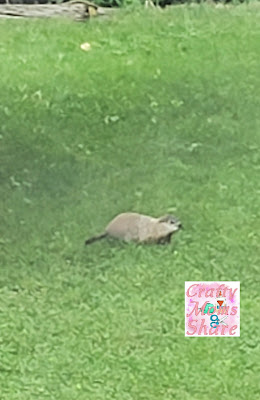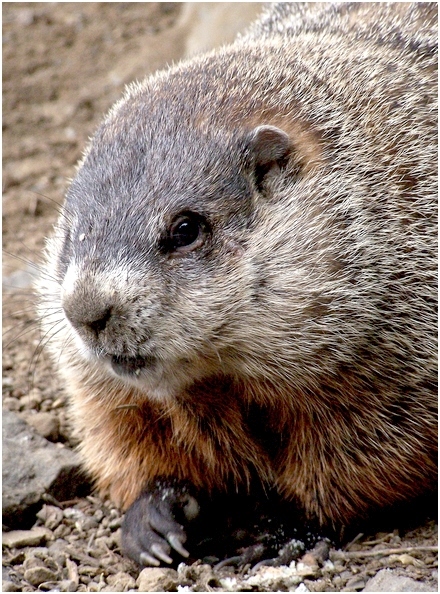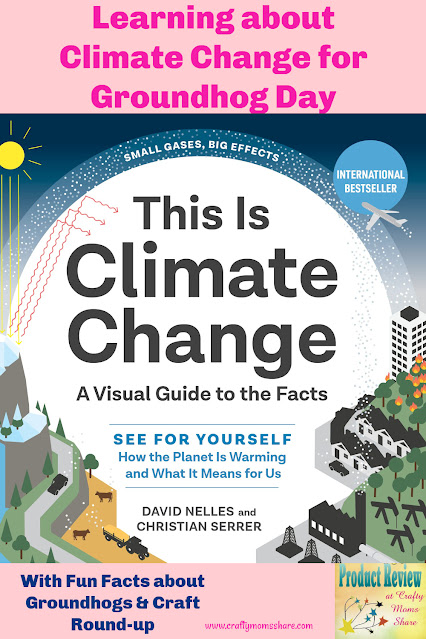Disclosure: I was sent a copy of this book in exchange for an honest review. All opinions are my own.
Did you see the Groundhog Day video I shared on Facebook? It is the annual Groundhog Day video of Ms. G, the official groundhog of Massachusetts. I like watching this video more than Punxsutawney Phil. One Ms. G is closer to me and has weather more like mine. Two, she isn't surrounded by all the news cameras with the extra lights to make shadows. Plus I love how they share a bit about groundhogs, animals and more. She lives at Mass Audubon's Drumlin Farm Wildlife Sanctuary. We loved visiting Drumlin Farm when Hazel was young. In the video they say Groundhog Day is also Climate Action Day. So today I'm going to share some fun facts about groundhogs with a small craft round-up and share with you a new book about climate change. We all need to be aware of climate change and take action to help stop/slow it.
 |
| Groundhog in our backyard this summer |
Fun Facts about Groundhogs
- Groundhogs are solitary animals. They only seek out their own kind to mate.
- They are related to squirrels. They are marmots.
- They can be found in Northern Canada all the way to Northern Alabama. They are even in Alaska.
- Groundhogs hibernate and they are known as “true hibernators”. They go into a dormant state where their body temperature (from 99 degrees to as low as 37 degrees) and heart rate (from 80 beats per minute to 5) fall dramatically. Their breathing slows from 16 breaths per minute to as few as 2. The groundhog will lose no more than a quarter of its bodyweight during hibernation. They hibernate from late fall until late winter or early spring.
- Their upper and lower incisors grow about one sixteenth of an inch a week!
- Before they hibernate they feast. Their summer feast includes plants and vegetables but also grubs, grasshoppers, insects, snails, other small animals and bird eggs. They can eat as much as one pound of food at a time during the summer feast. Many farmers and gardeners consider them pests. They apparently like clover since the groundhog in our backyard this summer spent quite a bit of time in the clover patch (see photo above).
- The male groundhogs wake up early to get a head start on mating. They defend their territory which usually includes burrows of several females. They go from burrow to burrow to find out if the female is still there. Once he knows he returns to his burrow to sleep for another month.
- Most mating happens in ten days during March. They mate then so their babies will have the best chance for survival.
- A burrow can be anywhere between eight to 66 feet in length and has several entrances and exits. It can also be six feet deep. They have different chambers including one they use as a bathroom. Some groundhogs have different burrows for the different seasons while others have chambers in their burrow for hibernating versus the summertime when they want easy entrances and exits. When a groundhog moves out other animals may use the burrow. Animals like chipmunks, rabbits and snakes enjoy the spacious homes.
- They have many different names from woodchuck to whistle pig. The belief is that woodchuck comes from a Native American word for the animal. The Algonquian name is wuchak. The Cree word for a fisher is otchek and some believe the Europeans misapplied it to a groundhog.
- There are many beliefs for how Groundhog’s Day started. Some say it is related to traditions with Candlemas (also February 2nd). A sunny Candlemas meant a long winter in folklore. Europeans however used a hedgehog or badger to determine the length of the winter. It is believed that since the Germans in Pennsylvania couldn’t find a hedgehog or badger, they used the groundhog since it was about the same size.
- They can climb trees and they can swim if they absolutely have to.
- A study of 30 years of groundhog predictions shows they are only right about 37% of the time.
 |
| Photo by User:Eiffelle, CC BY-SA 2.5, via Wikimedia Commons |
Sources:
- Breyer, Melissa. Treehugger. “8 Fun Facts About Groundhogs.” (3 Jan 2021) https://www.treehugger.com/groundhogs-explained-4857655
- CBC Kids. “All About Groundhog Day.” https://www.cbc.ca/kidscbc2/the-feed/whats-the-story-groundhog-day
- CBC Kids. “5 Fun Facts About Groundhogs.” https://www.cbc.ca/kidscbc2/the-feed/5-fun-facts-about-groundhogs
- Di Silvestro, Roger. National Wildlife Federation. “10 Things You May Not Know About Groundhogs.” (13 Jan 2011) https://blog.nwf.org/2011/01/10-things-you-may-not-know-about-groundhogs/
- Sirucek, Stefan. National Geographic. “10 Facts You Didn’t Know About Groundhogs.” (31 Jan 2020) https://www.nationalgeographic.com/animals/article/groundhogs-day-animals-wildlife
Groundhog Crafts
1) Groundhog masks
2) Groundhog paper plate craft
Climate Change / Climate Action Day
For Climate Action Day we are sharing with you a new scientific book called This Is Climate Change: A Visual Guide to the Facts See for Yourself How the Planet Is Warming and What It Means for Us by David Nelles and Christian Serrer.
From the Publisher:
The essential, all-in-one guide to climate change—packed with easy-to-understand infographics on all the latest scientific findings.
From Me:
Although each page is short, the information is all there. There is no recommended age range, and it is not necessarily a children's book, but middle school and high school kids could definitely read it and use it in school or at home. It is also appropriate for adults who want to learn more or understand climate change better. I love how it relates global warming of today with global changes that happened millions of years ago and how this one is different. It also shares how humans are causing it this time. This to me is such an important part of it because my husband often argues about global warming saying that it could be another natural occurrence like has happened in the past. This book has it all and is a must read for everyone on the planet!
So take some time today and learn about climate change and take action to help slow or stop it before it is too late for our planet, the animals and us! I hope you will check it out!







No comments:
Post a Comment
I love to hear your comments and ideas. Thank you for reading and contributing!